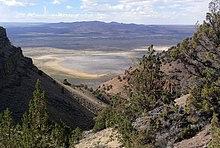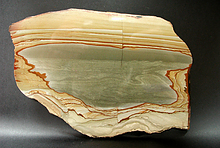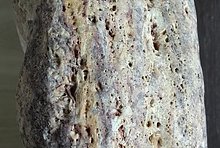Goldfield-- Short but Sweet!
Last Updated: 9th May 2020By Nathalie Brandes
Discovered in 1902, Goldfield quickly grew into Nevada’s largest city. Peak production from the rich but confusing epithermal ore occurred in 1910. By 1912, both the population and production were declining. In those few short years, Goldfield rose to prominence and faded into obscurity but remains a fascinating locality for those interested in geology and mining history.
Goldfield is located in the Goldfield Hills about 45 km (28 mi) south of Tonopah, Nevada. The mining district sits at an elevation of ~1740 m (~5700 ft), although the surrounding hills rise as high as 2100 m (6900 ft). The climate is arid, resulting in little vegetation. Highway 95 runs through Goldfield today, but early in the 20th Century three standard gauge railways also served the city (Ransome, 1909; Ashley and Albers, 1975).
The Goldfield Mining District sits at the western margin of a Tertiary volcanic centre (Ashley and Silberman, 1976). Typical rocks of the district include volcanic breccia, rhyolite, quartz latite, trachyandesite, and rhyodacite overlying Ordovician metasediments and granitic rocks (Ashley, 1974; Ashley and Albers, 1975). The oldest of these volcanic rocks are Oligocene (30-31 Ma). During this eruptive episode, a caldera and associated ring fracture system formed. After a period of quiescence, volcanism resumed around 22 Ma with the eruption of trachyandesite and rhyodacite (Ashley, 1974; Ashley and Silberman, 1976).
Goldfield is the largest known high sulphidation gold deposit in North America (Blakely et al., 2007). These types of epithermal deposits tend to form adjacent to volcanic centres where magmatic volatiles, such as HCl and SO2, rise and are absorbed by meteoric water, resulting in an acidic fluid that leaches rock (White and Hedenquist, 1995). In the case of Goldfield, this mineralisation occurred about 20-21 Ma with the shallow emplacement of a pluton. Ore fluids followed fractures and faults associated with the prior volcanic activity of the region, including the Oligocene ring facture system. Rock closest to the factures was silicified whereas rock farther from the fractures was argillised (Ashley and Albers, 1975; Ashley and Silberman, 1976). Supergene mineralisation occurred between 9 and 12 Ma based on alunite formation (Ashley and Silberman, 1976).
The Goldfield Mining District occupies an area of about 39 km2 (15 mi2) of hydrothermally altered rock, however, the richest ores were concentrated in an area of only 1.3 km2 (0.5 mi2) (Ashley, 1974; Ashley and Silberman, 1976). Gold occurred within the silicified zones of the altered Tertiary volcanic rocks (Collins, 1907; Ransome, 1909; Locke, 1912; Ashley and Albers, 1975). Changes in grade, even within the silicified zone, were abrupt, often going from rich ore to barren rock within a metre (3.3 feet) (Collins, 1907; Ransome, 1909; Ashley, 1974; Ashley and Albers, 1975). Typically the highest grade ore occurred in brecciated parts of unoxidised ore zones. Often the brecciated pieces would be covered with quartz, pyrite, famatinite, tetrahedrite-tennantite, bismuthinite, goldfieldite, native gold, and sometimes tellurides and sphalerite. This ore commonly produced 440-580 oz/ton gold. The richest carload of ore, however, was extracted from the Mohawk Mine in 1906 and produced 609.6 oz/ton gold and 75.4 oz/ton silver (Ashley, 1974).
The first claims at Goldfield were staked on 4 December 1902 by Harry Stimler and William Marsh, a pair of prospectors who had been grubstaked by Jim Butler of Tonopah (Elliott, 1987). The prospectors named their site “Grandpa.” Soon more gold strikes were made, more claims were staked, and a rush to the new district began. By 1903, a town was organised and given the name Goldfield (Zanjani, 2002). Mines in the district operated under a leasing system in which a company was granted a lease along a vein and paid the claim owner a percentage of the production after operating costs. This led to the development of many mining companies until most were consolidated by George Nixon and George Wingfield as the Goldfield Consolidated Mines Company (Ransome, 1909, Elliott, 1966; Elliott, 1987).
Just five years after the initial discovery of ore, Goldfield became the largest city in Nevada with a population near 20,000 (Zanjani, 2002). The glory days of rich ore in Goldfield were short-lived. Labour tensions rose with the arrival of the Western Federation of Miners union and strikes broke out in 1906 and 1907. Fearing violence, as had occurred in Leadville, Colorado and other mining towns, federal troops were dispatched to maintain order. The strike ended with no major episodes of violence and mining companies refusing to employ Western Federation of Miners members. Peak production from the mines occurred in 1910 with 539,000 oz gold and 118,000 oz silver produced (Ashley, 1974). Following that year, large numbers of the population began leaving. By 1912, a local mining engineer reported to a friend that all who were able had left that spring. Mining continued for a few more years, but in 1919 the Goldfield Consolidated Mill shut down and with it large-scale mining ended (Zanjani, 2002).
The town seen today is but a small part of what once existed. A major flash flood destroyed part of the town in 1913. Ten years later, a bootlegger’s still ignited a fire that swept through many of the remaining buildings (Zanjani, 2002). If one visits Goldfield today, one can still see the hotel, the courthouse, the school, and of course, the headframes and tailings piles of a legendary mining locality.
References:
Ashley, R.P., 1974, Goldfield Mining District in Guidebook to the Geology of Four Tertiary Volcanic Centers in Central Nevada: Nevada Bureau of Mines and Geology, Report 19, p. 49-66.
Ashley, R.P. and Albers, J.P., 1975, Distribution of Gold and Other Ore Related Elements Near Ore Bodies in the Oxidized Zone at Goldfield, Nevada: USGS Professional Paper 843-A, 48p.
Ashley, R.P. and Silberman, M.L., 1976, Direct dating of mineralization at Goldfield, Nevada, by potassium-argon and fission track methods: Economic Geology, v. 71, p. 904-924.
Blakely, R.J., John, D.A., Box, S.E., Berger, B.R., Fleck, R.J., Ashley, R.P., Newport, G.R., and Heinemeyer, G.R., 2007, Crustal controls on magmatic-hydrothermal systems: a geophysical comparison of White River, Washington, with Goldfield, Nevada: Geosphere, v.3, p. 91-107.
Collins, E.A., 1907, The Combination Mine—I. Early development and geologic structure: Mining and Scientific Press, v. 95, p. 397-399.
Elliott, R.R., 1966, Nevada’s 20th Century Mining Boom; Tonopah, Goldfield, Ely: University of Nevada Press, 344p.
Elliott, R.R., 1987, History of Nevada, 2nd ed.: University of Nebraska Press, 472p.
Locke, A., 1912, The ore deposits of Goldfield: Engineering and Mining Journal, v. 94, p. 843-849.
Ransome, F.L., 1909, The Geology and Ore Deposits of Goldfield, Nevada: USGS Professional Paper 66, 258p.
White, N.C. and Hedenquist, J.W., 1995, Epithermal Gold Deposits: Styles, Characteristics, and Exploration: SEG Newsletter, n. 23, p. 9-13.
Zanjani, S.S., 2002, The Glory Days of Goldfield, Nevada: University of Nevada Press, 141p.
Goldfield is located in the Goldfield Hills about 45 km (28 mi) south of Tonopah, Nevada. The mining district sits at an elevation of ~1740 m (~5700 ft), although the surrounding hills rise as high as 2100 m (6900 ft). The climate is arid, resulting in little vegetation. Highway 95 runs through Goldfield today, but early in the 20th Century three standard gauge railways also served the city (Ransome, 1909; Ashley and Albers, 1975).
The Goldfield Mining District sits at the western margin of a Tertiary volcanic centre (Ashley and Silberman, 1976). Typical rocks of the district include volcanic breccia, rhyolite, quartz latite, trachyandesite, and rhyodacite overlying Ordovician metasediments and granitic rocks (Ashley, 1974; Ashley and Albers, 1975). The oldest of these volcanic rocks are Oligocene (30-31 Ma). During this eruptive episode, a caldera and associated ring fracture system formed. After a period of quiescence, volcanism resumed around 22 Ma with the eruption of trachyandesite and rhyodacite (Ashley, 1974; Ashley and Silberman, 1976).
Goldfield is the largest known high sulphidation gold deposit in North America (Blakely et al., 2007). These types of epithermal deposits tend to form adjacent to volcanic centres where magmatic volatiles, such as HCl and SO2, rise and are absorbed by meteoric water, resulting in an acidic fluid that leaches rock (White and Hedenquist, 1995). In the case of Goldfield, this mineralisation occurred about 20-21 Ma with the shallow emplacement of a pluton. Ore fluids followed fractures and faults associated with the prior volcanic activity of the region, including the Oligocene ring facture system. Rock closest to the factures was silicified whereas rock farther from the fractures was argillised (Ashley and Albers, 1975; Ashley and Silberman, 1976). Supergene mineralisation occurred between 9 and 12 Ma based on alunite formation (Ashley and Silberman, 1976).
The Goldfield Mining District occupies an area of about 39 km2 (15 mi2) of hydrothermally altered rock, however, the richest ores were concentrated in an area of only 1.3 km2 (0.5 mi2) (Ashley, 1974; Ashley and Silberman, 1976). Gold occurred within the silicified zones of the altered Tertiary volcanic rocks (Collins, 1907; Ransome, 1909; Locke, 1912; Ashley and Albers, 1975). Changes in grade, even within the silicified zone, were abrupt, often going from rich ore to barren rock within a metre (3.3 feet) (Collins, 1907; Ransome, 1909; Ashley, 1974; Ashley and Albers, 1975). Typically the highest grade ore occurred in brecciated parts of unoxidised ore zones. Often the brecciated pieces would be covered with quartz, pyrite, famatinite, tetrahedrite-tennantite, bismuthinite, goldfieldite, native gold, and sometimes tellurides and sphalerite. This ore commonly produced 440-580 oz/ton gold. The richest carload of ore, however, was extracted from the Mohawk Mine in 1906 and produced 609.6 oz/ton gold and 75.4 oz/ton silver (Ashley, 1974).
The first claims at Goldfield were staked on 4 December 1902 by Harry Stimler and William Marsh, a pair of prospectors who had been grubstaked by Jim Butler of Tonopah (Elliott, 1987). The prospectors named their site “Grandpa.” Soon more gold strikes were made, more claims were staked, and a rush to the new district began. By 1903, a town was organised and given the name Goldfield (Zanjani, 2002). Mines in the district operated under a leasing system in which a company was granted a lease along a vein and paid the claim owner a percentage of the production after operating costs. This led to the development of many mining companies until most were consolidated by George Nixon and George Wingfield as the Goldfield Consolidated Mines Company (Ransome, 1909, Elliott, 1966; Elliott, 1987).
Just five years after the initial discovery of ore, Goldfield became the largest city in Nevada with a population near 20,000 (Zanjani, 2002). The glory days of rich ore in Goldfield were short-lived. Labour tensions rose with the arrival of the Western Federation of Miners union and strikes broke out in 1906 and 1907. Fearing violence, as had occurred in Leadville, Colorado and other mining towns, federal troops were dispatched to maintain order. The strike ended with no major episodes of violence and mining companies refusing to employ Western Federation of Miners members. Peak production from the mines occurred in 1910 with 539,000 oz gold and 118,000 oz silver produced (Ashley, 1974). Following that year, large numbers of the population began leaving. By 1912, a local mining engineer reported to a friend that all who were able had left that spring. Mining continued for a few more years, but in 1919 the Goldfield Consolidated Mill shut down and with it large-scale mining ended (Zanjani, 2002).
The town seen today is but a small part of what once existed. A major flash flood destroyed part of the town in 1913. Ten years later, a bootlegger’s still ignited a fire that swept through many of the remaining buildings (Zanjani, 2002). If one visits Goldfield today, one can still see the hotel, the courthouse, the school, and of course, the headframes and tailings piles of a legendary mining locality.
References:
Ashley, R.P., 1974, Goldfield Mining District in Guidebook to the Geology of Four Tertiary Volcanic Centers in Central Nevada: Nevada Bureau of Mines and Geology, Report 19, p. 49-66.
Ashley, R.P. and Albers, J.P., 1975, Distribution of Gold and Other Ore Related Elements Near Ore Bodies in the Oxidized Zone at Goldfield, Nevada: USGS Professional Paper 843-A, 48p.
Ashley, R.P. and Silberman, M.L., 1976, Direct dating of mineralization at Goldfield, Nevada, by potassium-argon and fission track methods: Economic Geology, v. 71, p. 904-924.
Blakely, R.J., John, D.A., Box, S.E., Berger, B.R., Fleck, R.J., Ashley, R.P., Newport, G.R., and Heinemeyer, G.R., 2007, Crustal controls on magmatic-hydrothermal systems: a geophysical comparison of White River, Washington, with Goldfield, Nevada: Geosphere, v.3, p. 91-107.
Collins, E.A., 1907, The Combination Mine—I. Early development and geologic structure: Mining and Scientific Press, v. 95, p. 397-399.
Elliott, R.R., 1966, Nevada’s 20th Century Mining Boom; Tonopah, Goldfield, Ely: University of Nevada Press, 344p.
Elliott, R.R., 1987, History of Nevada, 2nd ed.: University of Nebraska Press, 472p.
Locke, A., 1912, The ore deposits of Goldfield: Engineering and Mining Journal, v. 94, p. 843-849.
Ransome, F.L., 1909, The Geology and Ore Deposits of Goldfield, Nevada: USGS Professional Paper 66, 258p.
White, N.C. and Hedenquist, J.W., 1995, Epithermal Gold Deposits: Styles, Characteristics, and Exploration: SEG Newsletter, n. 23, p. 9-13.
Zanjani, S.S., 2002, The Glory Days of Goldfield, Nevada: University of Nevada Press, 141p.
Article has been viewed at least 734 times.


















Goldfield Mining District, Esmeralda County, Nevada, USA